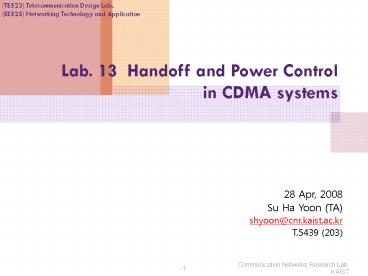Lab. 13 Handoff and Power Control in CDMA systems PowerPoint PPT Presentation
1 / 13
Title: Lab. 13 Handoff and Power Control in CDMA systems
1
Lab. 13 Handoff and Power Control in CDMA
systems
- 28 Apr, 2008
- Su Ha Yoon (TA)
- shyoon_at_cnr.kaist.ac.kr
- T.5439 (203)
2
Contents
- 1. Handoff
- 2. Power Control
- 3. Pre-Lab
- 4. Main-Lab
- 5. References
3
Handoff
- Systems are designed with some overlap in the
coverage areas between sites, because of user
mobility and the need of eliminating shadow areas
within the service area. - Handoff process
- When a MS is moving from one cell to another, the
MS undergoes procedures called handoff. - Handoff allows the MS to acquire the pilot
channel transmitted by neighboring base station
transceiver system (BTS) and to make another
connection to a new BTS, while maintaining a
connection to the old BTS. - To perform a handoff process, every MS measures
and internally stores the information about
neighboring Forward Pilot Channels (FPiChs)
acquired in its current location.
4
Handoff Pilot Sets
- Active set
- Pilots of CDMA carriers are being monitored while
in idle state. - During a call, these are the pilots associated
with forward traffic channels assigned to the MS. - Candidate set
- Pilots not currently in the active set but with
enough signal power level to become an active
pilot. - Neighbor set
- Pilots that do not belong to the active or
candidate sets but may be also considered
candidates for a handoff process - Remaining set
- All remaining pilots that do not belong to any of
the other sets but exists in the area where the
MS is located
5
Handoff Types
- Soft handoff
- A soft handoff is applied to an MS that starts
communication with a new BTS while still
connected to another BTS - Make-before-break
- Hard handoff
- A MS is disconnected from one BTS and is switched
to another - Break-before-make
- Softer handoff
- A special soft handoff between sectors in the
same BTS - Idle handoff
- An idle handoff is performed while in idle state
when the MS is moving from one BTS to another - Access handoff
- An access handoff occurs in the system access
state when the MS is performing access attempts.
6
Power Control (1/3)
- FER is the most common network quality parameter
to execute power control - Ec/Io (ratio of chip energy, Ec, to interference
noise spectral density) - Eb/Io (ratio of bit energy, Eb, to interference
noise spectral density) - Power control aims to quickly and efficiently
estimate the minimum MS transmission power to
achieve the required communication quality (based
on FER statistics) - Benefits of power control in CDMA systems
- Increase in system capacity
- Minimization of near-far effect
- Increase in battery lifetime
7
Power Control (2/3)
- Open loop power control
- Usually implemented as the initial power control
to give an estimate of minimum transmission power
used for access channels, such as Reverse Access
Channels (RAChs), Enhanced Access Channels
(EAChs), and Reverse Common Control Channels
(RCCChs), during system access state. - Closed loop power control
- Usually implemented for traffic channels, which
need a more sophisticated power control system.
cdma2000 systems can also employ this type of
power control even during the system access state.
8
Power Control (3/3)
- Procedure of the closed loop power control
- An MS initially uses the transmission power
defined in the last message from last access
probe transmitted on the system access state. - The BTS determines a set point power level,
which is considered ideal for receiving signals
within a certain QoS. - The set point is periodically adjusted.
- The BTS performs power control by transmitting
power control bits, which instruct MSs
individually to increase or reduce transmission
power according to the estimated set point value.
9
Pre-Lab (1/2)
- Explain the roles of PN code, rake receiver,
searcher, and finger briefly. - Explain the active/candidate/neighbor set in the
handoff process briefly. - Fig. 7 shows the procedure of soft handoff.
Explain the procedure of soft handoff using the
figure. - The handoff process consists of 4-steps
initialization, resource reservation, execution,
and completion. Explain each step briefly. - What is the near/far problem in CDMA systems and
how to solve this near/far problem in the CDMA
system? - Both open-loop power control and closed-loop
power control are used in the CDMA systems.
Explain the difference between open-loop power
control and closed-loop power control briefly.
10
Pre-Lab (2/2)
Due date Before the experiment
11
Main-Lab (1/2)Handoff
- Handoff
- Fill the following table and record the data
- PN offset
- Ec/Io
- RSSI
- Finger State
- Active / Candidate / Neighbor
- Varying the location slowly, fill the following
table and record the data - Explain the difference before and after handoff
using the recoded data - Analyze collected data
- Using the recorded data pilot set status,
temporal analyzer graph, PN history graph, and
finger graph, explain the handoff procedure.
12
Main-Lab (2/2)Power Control
- Power Control
- Power control during call processing
- Record data during idle mode
- Record data during call origination / active
phase - Record data during call delivery / clearing
- Power control of moving users
- Varying the location slowly, fill the following
table and record the data - PN offset, RSSI
- Tx./Rx. Power, Tx. Adjust
- Ec/Io, FER
- Analyze collected data
- Using the recorded data pilot set status,
temporal analyzer graph, PN history graph, finger
graph, and IS-95 signal graph, explain the power
control procedure.
13
References
- Korowajczuk, et al., Designing cdma2000 systems
- Garg, Wilkes, Wireless and personal
communications systems - Lee, Miller, CDMA systems engineering handbook
- CC Inst., ANYPA-IMT2000 Protocol Analyzer
Operation Manual - http//www.3gpp.org
- http//www.3gpp2.org

